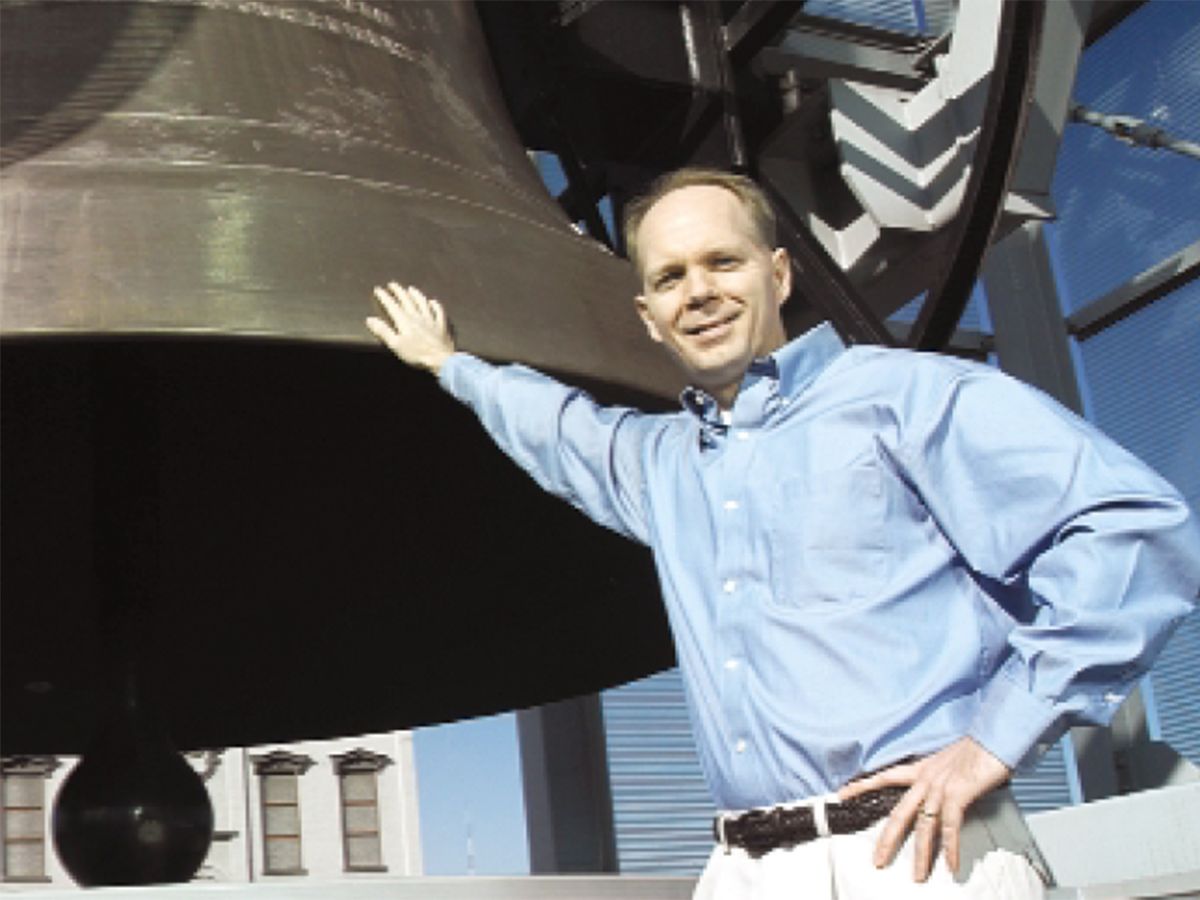Keith Donovan: The Tintinnabulator
His name may not ring a bell, but he designs the sophisticated electronics used in bell and clock towers, monuments, and animatronic figures

Strolling through a postcard-perfect New England town, you hear the solemn bells of a nearby church striking the hour, and the moment seems steeped in centuries-old tradition. Thanks to handiwork, though, what you take for Old-World ambience—the tolling of those bells—may in fact be an ingenious facsimile.
There may not even be a real bell in that bell tower, just a digital recording, retrieved from flash memory, amplified, and projected out over industrial-grade speakers. Or the bell tower may contain special Dutch-cast bells, but with computer-controlled actuators and sensors that can be programmed to hammer out tunes from a nearly infinite playlist.
As chief engineer for The Verdin Co., in Cincinnati, one of the leading makers of bell and clock towers, Donovan oversees the design and installation of these often highly customized systems. It’s a small and rarefied industry. After all, nobody really needs a clock tower in the center of town. And yet, once it’s there, it becomes so prominent a part of the landscape—a point of pride, even—that everyone would hate to lose it. Donovan loves that part of the job. “Every project I work on is designed to make people feel good,” he says. “I’ve seen people cry at dedication ceremonies, they’re so moved.”
His earlier career didn’t have quite the same feel-good quality. After getting a BSEE from Purdue University, in West Lafayette, Ind., in 1988, he went to work at Dallas-based Texas Instruments Inc., designing night-vision systems for Abrams tanks. “I don’t have any moral problems about what I was doing. I felt like I was helping save soldiers’ lives,” Donovan says. “But, you know, tanks also kill people.”
By the mid-1990s, Donovan decided to return to the Midwest, ideally to his hometown of Cincinnati. His first stop was Indiana University, where he got an MBA. Then, one day, while leafing through the help-wanted ads in a Cincinnati newspaper, he spotted an opening with Verdin. Founded more than 160 years ago by two French immigrant brothers, and still in family hands five generations later, Verdin has built thousands of systems throughout North America and also abroad. Donovan had never heard of the company, despite its history, nor had he given much thought to clocks or bells. That changed quickly once he got the job.
Keith Donovan
Age: 38
What he does: Builds and installs electronics to auto- mate clock and bell towers
For whom: The Verdin Co.
Where he does it: Cincinnati and wherever else the company sends him
Fun factors: Builds challenging, one-of-a-kind systems that are designed to make people feel good
As Verdin’s sole EE, Donovan is the consummate multitasker. He tries not to get involved in routine installations. But when a client wants something special—animatronic figures for an amusement park, say, or a 96-bell tower complex for a monument—Donovan immerses himself in everything from the design to the actual installation.
He was also instrumental in developing an all-electronic carillon system called the Singing Tower Classic. It’s a squat black steel box that houses a dedicated computer for simulating the tones of up to 49 cast bronze bells. It costs about a tenth as much as the real thing, and it’s more versatile—the user can chose from among funereal tolls, bridal tolls, and the classic Westminster chime, as well as fromliterally thousands of melodies, all recorded in MIDI (musical instrument digital interface) format. The user can download new songs and tolls over the console’s built-in modem or plug in a keyboard and play the bells “live.”
How about “Freebird?” “That’s actually the number one request when people stop by to see what we’re doing,” Donovan says. With an electronic carillon, it’s technically possible to play even the most contorted rock riff, whereas a real bell can’t handle a quick series of notes because of the lag time between strikes.
But for Donovan, what matters most is not what the bells play but that they play perfectly, every time. “Whenever you install a new system, you feel nervous—‘Oh, no, what if it doesn’t work?’ ” he says. “Everybody’s watching and waiting. And then it works, and you feel great.”
To Probe Further
To find detailed descriptions of the electronic carillons and electric bell-ringing devices of the kind Keith Donovan works with, see https://www.verdin.com/.